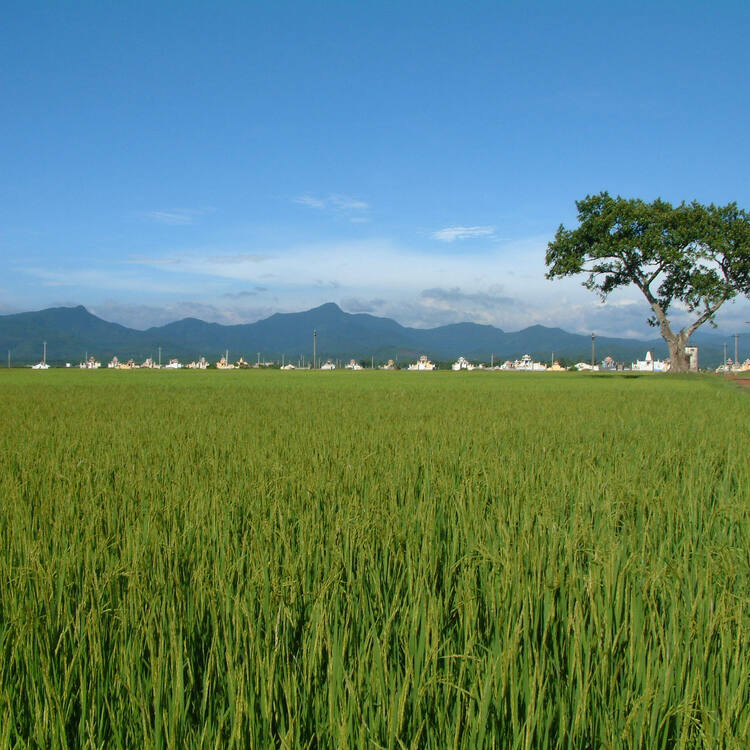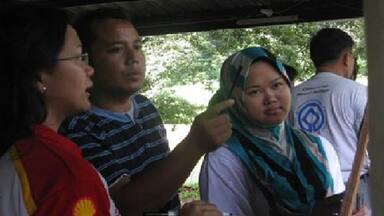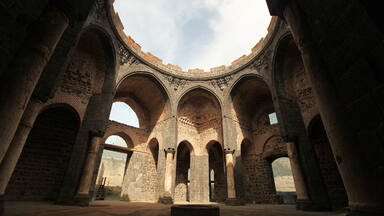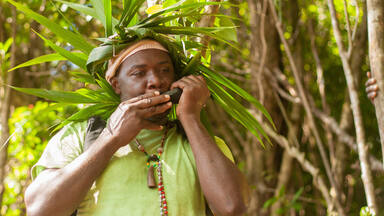Phong Nha-Ke Bang National Park
Phong Nha-Ke Bang National Park
The Phong Nha-Ke Bang National Park, inscribed on the World Heritage List in 2003, covered 85,754 hectares. With this extension, the site covers a total surface area of 123,326 hectares (a 46 % increase) and shares a boundary with the Hin Namno Nature Reserve in the Peoples Democratic Republic of Laos. The Park’s landscape is formed by limestone plateaux and tropical forests. It features great geological diversity and offers spectacular phenomena, including a large number of caves and underground rivers. The site harbours a high level of biodiversity and many endemic species. The extension ensures a more coherent ecosystem while providing additional protection to the catchment areas that are of vital importance for the integrity of limestone landscapes.
Description is available under license CC-BY-SA IGO 3.0
Parc national de Phong Nha - Ke Bang
Le Parc national de Phong Nha-Ke Bang, inscrit en 2003 sur la Liste du patrimoine mondial, couvrait 85 754 ha. Avec cette extension, il atteint désormais la surface de 123 326 ha (soit une augmentation de 46%) et devient contigu avec la réserve naturelle de Hin Namno en République démocratique populaire lao. Le Parc présente un paysage de plateaux karstiques et de forêts tropicales, très divers du point de vue géologique et offre des phénomènes spectaculaires, dont de nombreuses grottes et rivières souterraines. Il abrite un haut niveau de biodiversité et de nombreuses espèces endémiques. L’extension assure un écosystème plus intact apportant une protection additionnelle aux bassins versants dont l’importance est vitale pour l’intégrité des paysages karstiques.
Description is available under license CC-BY-SA IGO 3.0
منتزه فونغ نا-كي بانغ الوطني
أُدرج هذا الموقع في قائمة التراث العالمي في عام 2003 وكان يغطي مساحة قدرها 754 85 هكتاراً. ونتيجةً لتوسيع نطاق الموقع، ارتفعت هذه المساحة إلى 123,326 هكتاراً (أي بنسبة 46 في المائة)، وبات المنتزه محاذياً لمحمية هين نامنو الطبيعية في جمهورية لاو الديمقراطية الشعبية. ويضم الموقع مجموعة من الأراضي الكارستية والغابات المدارية المتنوعة جداً من حيث تكوينها الجيولوجي، ويتميز بظواهر مدهشة تشمل مغارات وأنهاراً جوفية كثيرة. ويتسم المنتزه بتنوع بيولوجي كبير كما يضم العديد من الأصناف المستوطنة. وأتاح قرار توسيع نطاق الموقع تعزيز سلامة النظام الإيكولوجي للمنتزه وتأمين حماية أفضل لمستجمعات المياه التي تُعد ذات أهمية حوية في الحفاظ على الأراضي الكارستية.
source: UNESCO/CPE
Description is available under license CC-BY-SA IGO 3.0
方芽-科邦国家公园
方芽–科邦国家公园占地85,754公顷,于2003年载入世界遗产名录。扩展后,该遗产地面积将达到123,326公顷(同比增长46%)与老挝人民民主共和国的欣纳姆侬自然保护区相接。公园内有喀斯特高原地貌与热带雨林,多样化的地质特征和壮观的风貌,还有众多岩洞和地下河流。这里有为数众多的特有物种,体现了丰富的生态多样性。该遗产地的扩展保护了一套更完整的生态系统,为该地区的汇水盆地提供了额外的保护,这些盆地对保护当地喀斯特地貌的完整性至关重要。
source: UNESCO/CPE
Description is available under license CC-BY-SA IGO 3.0
Национальный парк Фонгня-Кебанг
До настоящего расширения Национальный парк Фонгня-Кебанг, включенный в Список Всемирного наследия в 2003 году, занимал площадь 85 754 га. После расширения его площадь составила 123 326 га. (увеличение на 46%). Новая территория объекта прилегает к заповеднику Хин-Намно в Лаосской Народно-Демократической Республике. Природа парка представлена тропическими лесами и карстовыми плато с разнообразными геологическими проявлениями. На его территории можно наблюдать удивительные природные объекты, в том числе многочисленные гроты и подземные реки. Заповедник отличается высоким уровнем биоразнообразия и служит местом обитания для большого количества эндемичных видов. Расширение территории объекта позволит сохранить целостность его экосистемы и обеспечить дополнительную защиту водосборных бассейнов, которые играют важную роль в формировании и сохранении карстового ландшафта.
source: UNESCO/CPE
Description is available under license CC-BY-SA IGO 3.0
Parque Nacional de Phong Nha–Ke Bang
Se trata de una extensión del sitio natural del mismo nombre, que se inscribió en la Lista del Patrimonio Mundial en 2003. Con esta ampliación el territorio del parque no sólo aumenta su superficie en un 46%, pasando de 85.754 a 123.326 hectáreas, sino que además extiende sus límites hasta confinar con la reserva natural de Hin Namno, situada en la República Democrática Popular Lao. En el paisaje se observa la presencia de bosques tropicales y mesetas kársticas de gran diversidad geológica, así como de abundantes grutas y ríos subterráneos sumamente espectaculares. El sitio posee un grado de diversidad biológica muy elevado y alberga numerosas especies endémicas. Con su extensión se garantiza mejor la integridad del ecosistema y se refuerza la protección de las cuencas hidrográficas, cuya importancia es esencial para mantener intactos los paisajes kársticos.
source: UNESCO/CPE
Description is available under license CC-BY-SA IGO 3.0
フォンニャ-ケバン国立公園
2003年に登録された、ラオス国境に位置する国立公園。約2700種の維管束植物、800種以上の脊椎動物が生育・生息し、それらのうち約400種の植物がベトナム固有種、38種の動物がこの地域の固有種である。今回、登録面積が46%拡張されるとともに、これまでの評価基準(viii)に、新たに生物多様性関連の(ix)(x)が加えられた。source: NFUAJ
Nationaal park Phong Nha-Kẻ Bảng
De karstformatie van het Nationaal park Phong Nha-Kẻ Bảng is het oudste karstgebied in Azië. Het is geëvolueerd sinds het Paleozoïcum (ongeveer 400 miljoen jaar geleden). Door ingrijpende tektonische veranderingen ontstond een zeer complex karstlandschap, gekenmerkt door veel en belangrijke geomorfologische kenmerken. Het erfgoed was oorspronkelijk ingeschreven in 2003 maar kreeg in 2015 een uitbreiding, waardoor de oppervlakte toenam met 46%. Het gebied - strekkend tot aan de grens van de Democratische Volksrepubliek Laos - bevat spectaculaire formaties zoals 65 kilometer aan grotten en ondergrondse rivieren. In het gebied komt een groot aantal faunale en florale soorten voor: meer dan 568 gewervelde diersoorten, waarvan 113 soorten zoogdieren, 81 soorten reptielen en amfibieën, 302 soorten vogels en 72 soorten vissen.
Source: unesco.nl
Outstanding Universal Value
Brief synthesis
Phong Nha-Ke Bang National Park is located in the middle of the Annamite Mountain Range in Quang Binh province, Viet Nam, and shares its boundary with the Hin Namno Nature Reserve in the Lao PDR to the west. The property comprises an area of 123,326 ha and contains terrestrial and aquatic habitats, primary and secondary forest, sites of natural regeneration, tropical dense forests and savanna and is rich in large, often spectacular and scientifically significant caves.
The property contains and protects over 104 km of caves and underground rivers making it one of the most outstanding limestone karst ecosystems in the world. The karst formation has evolved since the Palaeozoic period (some 400 million years ago) and as such is the oldest major karst area in Asia. Subject to massive tectonic changes, the karst landscape is extremely complex, comprising a series of rock types that are interbedded in complex ways and with many geomorphic features. The karst landscape is not only complex but also ancient, with high geodiversity and geomorphic features of considerable significance.
The karst formation process has led to the creation of not only underground rivers but also a variety of cave types including: dry caves, terraced caves, suspended caves, dendritic caves and intersecting caves. With a length of over 44.5 km the Phong Nha cave is the most famous of the system with tour boats able to penetrate inside to a distance of 1,500 m. The Son Doong Cave, first explored in 2009, is believed to contain the world’s largest cave passage in terms of diameter and continuity.
A large number of faunal and floral species occur within the property with over 800 vertebrate species recorded comprising 154 mammals, 117 reptiles, 58 amphibians, 314 birds and 170 fish. The property clearly has impressive levels of biodiversity within its intact forest cover, notwithstanding some gaps in knowledge of the population status of some species. .
Criterion (viii): Phong Nha-Ke Bang National Park is part of a larger dissected plateau, which encompasses the Phong Nha, Ke Bang and Hin Namno karsts. The limestone is not continuous and demonstrates complex interbedding with shales and sandstones. This has led to a particularly distinctive topography. The caves demonstrate a discrete sequence of events, leaving behind different levels of ancient abandoned passages; evidence of major changes in the routes of underground rivers; changes in the solutional regime; deposition and later re-solution of giant speleothems and unusual features such as sub-aerial stromatolites. On the surface, there is a striking series of natural landscapes, ranging from deeply dissected ranges and plateaux to an immense polje. There is evidence of at least one period of hydrothermal activity in the evolution of this ancient mature karst system. The Son Doong Cave, first explored in 2009, could contain the world’s largest cave passage in terms of diameter and continuity. The plateau is one of the finest and most distinctive examples of a complex karst landform in Southeast Asia and the property is of great importance for enhancing our understanding of the geologic, geomorphic and geo-chronological history of the region.
Criterion (ix): Phong Nha-Ke Bang National Park consists of a complex limestone landscape, which includes very large caves and underground rivers. The property includes karst formations which are some of the oldest and largest in Asia, and it has geological, climatic, hydrographic and ecological conditions which are distinct from other limestone karst landscapes. Its cave ecosystems and habitats are unique with high levels of endemism and adaptations displayed by cave-dependent species. The property constitutes one of the largest remaining areas of relatively intact moist forest on karst in Indochina, with a forest cover estimated to reach 94%, of which 84% is thought to be primary forest. Furthermore, the property protects globally significant ecosystems within the Northern Annamites Rainforests and Annamite Range Moist Forests priority ecoregions.
Criterion (x): A high level of biodiversity is found within the property, with over 2,700 species of vascular plants and over 800 vertebrate species. Several globally threatened species are also present: 133 plant species and 104 vertebrate species have been reported, including several large mammals such as the endangered Large-antlered Muntjac, Clouded Leopard, and the critically endangered Saola. The level of endemism is high, especially in the cave systems. Furthermore, it is estimated that over 400 plant species endemic to Viet Nam are found within the property, as well as 38 animal species endemic to the Annamite range. Several new species to science have recently been found, including cave scorpions, fish, lizards, snakes and turtles, and more species are likely to be discovered. Importantly, four threatened primate taxa endemic to the Annamites are found within the property: the Hatinh Langur (specialised in karst forest and endemic to Viet Nam and the People’s Democratic Republic of Lao), the black form of the Hatinh Langur, sometimes considered as a separate species, the Red-shanked Douc Langur, and the largest remaining population of White-cheeked Gibbon.
Integrity
The property constitutes one of the largest protected karst landscapes in South East Asia. Covering an area of 123,326 ha and bounded to the west by the Lao People’s Democratic Republic, all elements necessary to manifest the outstanding geological values of the property of Phong Nha-Ke Bang National Park are contained within the boundaries of the property. The inscribed property is completely surrounded and protected by a buffer zone of 220,055 ha and is designated into three management zones: a strictly protected, an ecological restoration and an administrative/service zone. The watershed protection forests in the buffer zone also protect the integrity of the property. Furthermore, the extension of the property enhances its integrity and connectivity with the karst landscape in Lao PDR.
There are, however, a number of issues that affect the integrity of the property. Wildlife poaching and illegal harvesting of forest products are a direct threat to biodiversity values. The property has also suffered from past developments and its integrity could be threatened by further uncontrolled tourism developments, notably by the proposed construction of a cable car and access roads. There is a need for the implementation of Environmental Impact Assessments for any projects which could negatively affect the site. This would ensure that the natural landscape, geologic and geomorphic values, and key features such as primitive forest, caves, rivers and streams within the inscribed area remain intact. The property is situated within an area of high population density and as such a number of activities, such as cultivation, tourism, transport and freshwater fisheries could also impact on its integrity.
Protection and management requirements
Originally designated as a Nature Reserve in 1986, Phong Nha-Ke Bang National Park was established in 2001 under the Decision 189/QD-TTg by the Prime Minister and is managed by a Management Board. The Management Board is responsible for protection of forest resources and biodiversity and was established in 1994. Cave conservation and the provision of a tourism service are the responsibility of the Cultural and Ecological Tourist Centre under the Management Board. The property is also included in the Special National Heritage List (2009), and the Special Use Forest system (1999). The National Park is effectively protected by a number of national laws and government decisions, which prohibit any action inside or outside the boundaries of the National Park or a World Heritage property that may have a significant impact on the heritage values.
A Strategic Management Plan has been in place since 2012 and is based on existing plans, including the Sustainable Tourism Development Plan, the National Park Operation Management Plan and the Buffer Zone Development Plan. The Management Board oversees law enforcement programmes including ranger patrols and joint law enforcement operations on the border with Lao PDR. Nevertheless, the rugged nature of the country and community dependence on natural resources coupled with relatively limited resources for enforcement means that wildlife poaching and illegal timber gathering are difficult to eradicate and remain a challenging issue.
The Ho Chi Minh highway, constructed outside and to the north of the property is appropriately located and provides important and valuable benefit to the National Park in terms of opening up views of and access to the Ke Bang forest area. However, other road construction and tourism development will require rigorous and comprehensive assessment of environmental impact before decisions are made on whether they should be permitted or not. It is paramount that such developments do not impact on the karst and biological values for which the property has been inscribed. Impacts of increased development pressure and tourism numbers will also require continual consideration, planning and management to ensure that these pressures do not damage the Outstanding Universal Value of the property. The property clearly has impressive levels of biodiversity within its intact forest cover, however, up-to-date data on large mammal species is also needed to confirm the population status of reported large mammals including tiger, Asiatic black bear, Asian elephant, giant muntjac, Asian wild dog, gaur and the recently discovered saola.

 View photos from OUR PLACE the World Heritage collection
View photos from OUR PLACE the World Heritage collection


